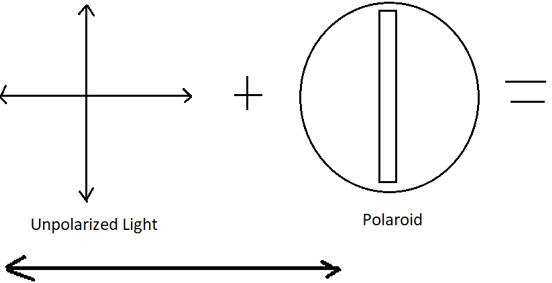This set of Engineering Physics Multiple Choice Questions & Answers (MCQs) focuses on “Polaroids”.
1. Which of the following is a uniaxial crystal?
a) Borax
b) Mica
c) Quartz
d) Selenite
View Answer
Explanation: Uniaxial crystals are those in which there is only one optic axis. Calcite, quartz, ice are a few examples. Borax, mica, and selenite are biaxial crystals which have two optic axes.
2. The alignment of the molecules in a polaroid gives the ____________
a) Propagation axis
b) Polarization axis
c) Unpolarized axis
d) Pass-axis
View Answer
Explanation: When a light wave is polarized, the electric vectors along the direction of propagation are absorbed by the polaroid. The alignment of the molecules in the polaroid gives us the polarization axis.
3. A polaroid with molecules aligned vertically would have polarization axis in the ____________
a) Vertical Direction
b) Horizontal Direction
c) The direction of incident light
d) Resultant of vertical and incident light
View Answer
Explanation: In a polaroid, any vibrations that are perpendicular to the direction of the molecules are eliminated. Thus, in the given case, all the vibrations in the vertical direction would be blocked and hence, the polarization axis would be in the horizontal direction.
4. The intensity of the light when viewed through a polaroid ____________
a) Increases to a small extent
b) Increases infinitely
c) Remains Same
d) Decreases finitely
View Answer
Explanation: As the vibrations in one direction are eliminated by the polaroid, the intensity of the emergent beam becomes half of the incident beam. Thus, when an image is viewed through a polaroid, it appears dimmer.
5. By using two Polaroids, one can completely block all the light coming from an object.
a) True
b) False
View Answer
Explanation: Imagine that one filter is placed such that all the horizontal vibrations are eliminated and only the vertical vibrations remain. If we adjust the second polaroid in such a way that all the vertical vibrations get blocked, then that would mean all the light coming from an object would be completely blocked. Thus, the given statement is true.
6. The second polaroid placed after the ray has been polarized is called as ____________
a) Polarizer
b) Analyzer
c) Brewster’s Window
d) Multi Polaroid
View Answer
Explanation: The second polaroid is placed after the ray has already been polarized to analyze whether the ray is polarized completely or not. Thus, it is called the polarizer.
7. A polarized light of Intensity 35 Wm2 is incident on the analyzer at a certain angle. If the transmitted beam has an Intensity of 30 Wm2, the angle made with the vertical is __________
a) 23°
b) 34°
c) 47°
d) 19°
View Answer
Explanation: Here, Io = 35 Wm-2, I = 30 Wm-2
Using Malus law, I = Iocos2θ
30 = 35 X cos2 θ
cos2 θ = 0.85
cos θ = 0.921
θ = 23°.
8. A polaroid can be used to polarize sound waves.
a) True
b) False
View Answer
Explanation: Longitudinal waves cannot be polarized as their direction is the same as its vibration. Thus, it’s intensity will not change as it passes through a rotating analyzer.
9. Which of the following shows the emergent beam correctly?
a) 
b) ![]()
c) 
d) 
View Answer
Explanation: As we know that the polaroid blocks the vibration of the unpolarized beam in one direction. In the following case,
10. Unpolarized light is incident on a polaroid of refractive index 1.2. What should be the angle of incidence such that the reflected and refracted rays are perpendicular to each other?
a) 50.19°
b) 55.23°
c) 57.45°
d) 60.89°
View Answer
Explanation: Using Brewster’s Law, μ = tanip
In this case, i + r is equal to μ/2.
For glass, μ = 1.2
Therefore, ip = tan-1μ = 50.19°.
Sanfoundry Global Education & Learning Series – Engineering Physics.
To practice all areas of Engineering Physics, here is complete set of 1000+ Multiple Choice Questions and Answers.
If you find a mistake in question / option / answer, kindly take a screenshot and email to [email protected]
